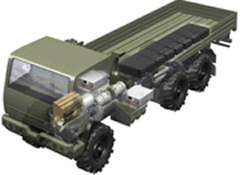Among the leaders in Serial Hybrid truck application is Oshkosh Truck Corp., which implemented the design in its new Heavy Expanded Mobility Tactical Truck (HEMTT) A3 third-generation prototype. HEMTT A3 unveiled in February 2005 was the first production-ready tactical defense vehicle to feature a diesel-electric drive system known as ProPulse Hybrid Electric Drive system. The same technology is implemented in the FMTV versions proposed by Oshkosh for the US Army.
The prototype HEMTT A3 is also equipped with an enhanced load handling system, an independent suspension and collision avoidance system. According to Oshkosh, all the technologies used for the prototype are matured and once approved for production, the vehicle roll out of the assembly lines is scheduled within two years.
Oshkosh uses a proprietary technology called ProPulse, which uses a diesel engine to power a large electric generator, which provides direct power to the wheels, eliminating the torque converter, automatic transmission, transfer case, and drive shafts. The system has no batteries, using ultracapacitors for energy storage instead. Designed for service life of 10 – 20 years, the ultracapacitors are less sensitive to extreme cold than batteries. A regenerative braking function stores engine energy and then uses it to assist in the next braking operation, reducing wear and tear on the brake system. According to Oshkosh, this mechanism increases fuel economy by up to 20 percent over conventional power trains.
When stationary, the HEMTT A3 becomes a power station, generating 200 kW of exportable power with the current 450 hp engine. If uprated to a 505 hp engine, it could generate 400 kW. The vehicle is 3,000 pounds lighter than its predecessor while maintaining a 13-ton payload capacity and improving reliability through the use of lightweight, high-strength materials. This allows the new truck to carry cargo while in transit on a C-130 aircraft, a first for the HEMTT line. An integral armored cab can field-installed in less than eight hours allowing commanders to respond to changing threat levels rapidly.
Several companies are competing for a future Army program to demonstrate “plug-in” version of the US Army FMTV truck. BAE Systems built a two-wheel drive hybrid FMTV truck, under contract to the FMTV manufacturer Stewart and Stevenson back in 1999. BAE also developed a six-wheel-drive hybrid prototype as part of a technology demonstration under the FCS program. This truck already demonstrated improved fuel economy, compared to conventionally driven FMTV truck. The vehicle can also produce 200 kW of continuous exportable power.
A future replacement for today’s military trucks could be the Future Tactical Truck System (FTTS), Advanced Concept Technology Demonstration (ACTD) managed by The National Automotive Center (NAC), which reports to the Army Tank-Automotive and Armaments Command. NAC is sponsoring demonstrations for light, medium (utility) and heavy (maneuver sustainment) hybrid-electric trucks and specific technology developments for motor, generator, and energy storage and power control technologies.
The British MOD is also looking at the potential benefits of HED, under a program led by QinetiQ. The British HED 6×6 demonstrator vehicle will incorporate a serial HED system employing ‘in-hub’ electric drive systems. The QinetiQ team includes Magnetic Systems Technology, Multidrive and BAE Systems Land Systems (formerly Vickers Defence Systems).
Additional parts of this article:
- Military Applications of Hybrid Cars and Trucks
- Technical Principles of Hybrid Electric Drive
- Plug-in Hybrid Electric Vehicles (HED) the Humvee example
- Hybrid Electric Vehicles (HED) Powered Trucks
- Hybrid Electric Drives (HED) For Armored Fighting vehicles
- Power Sources and Batteries for Hybrid Electric Drive (HED) Vehicles




















